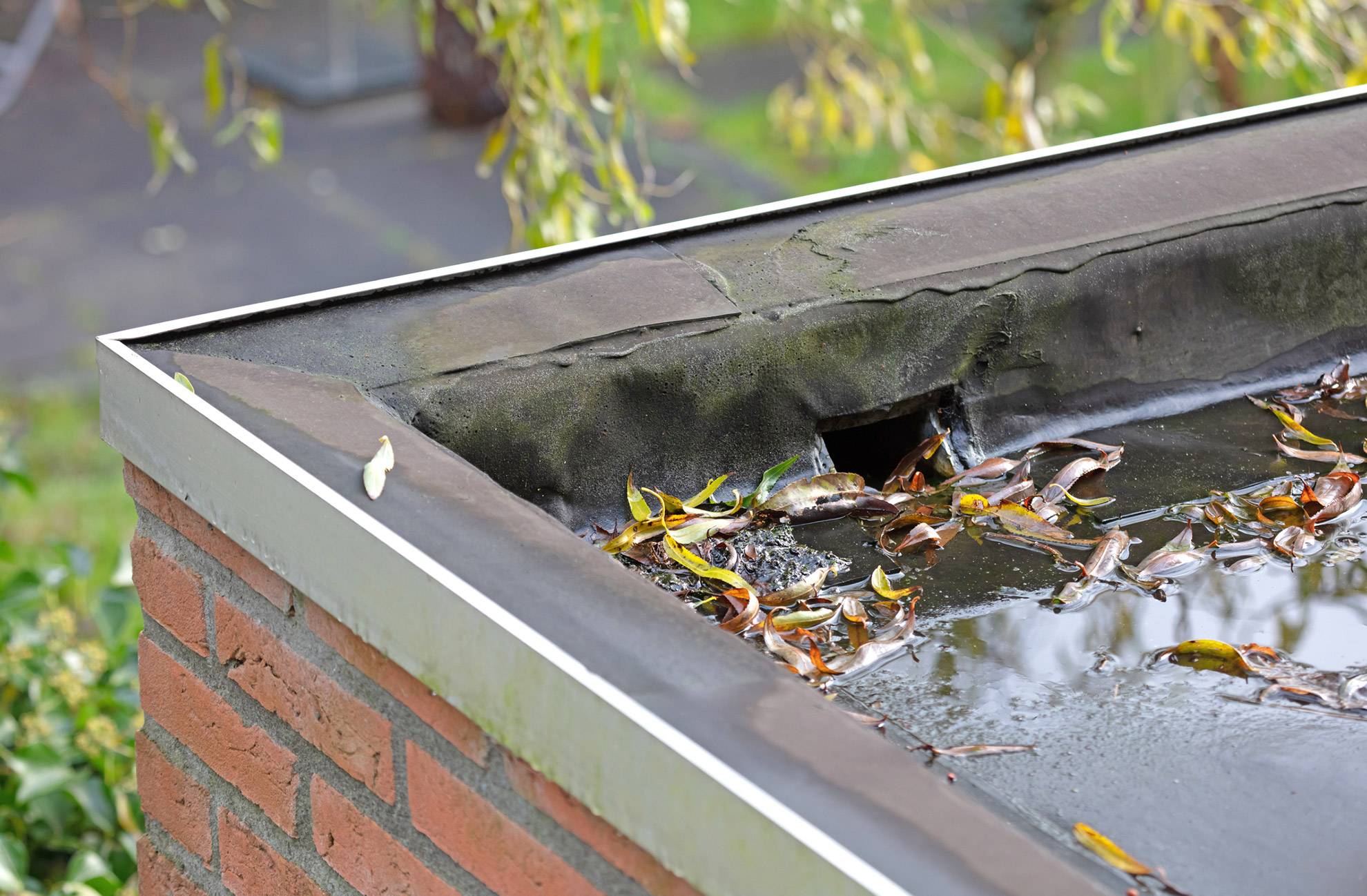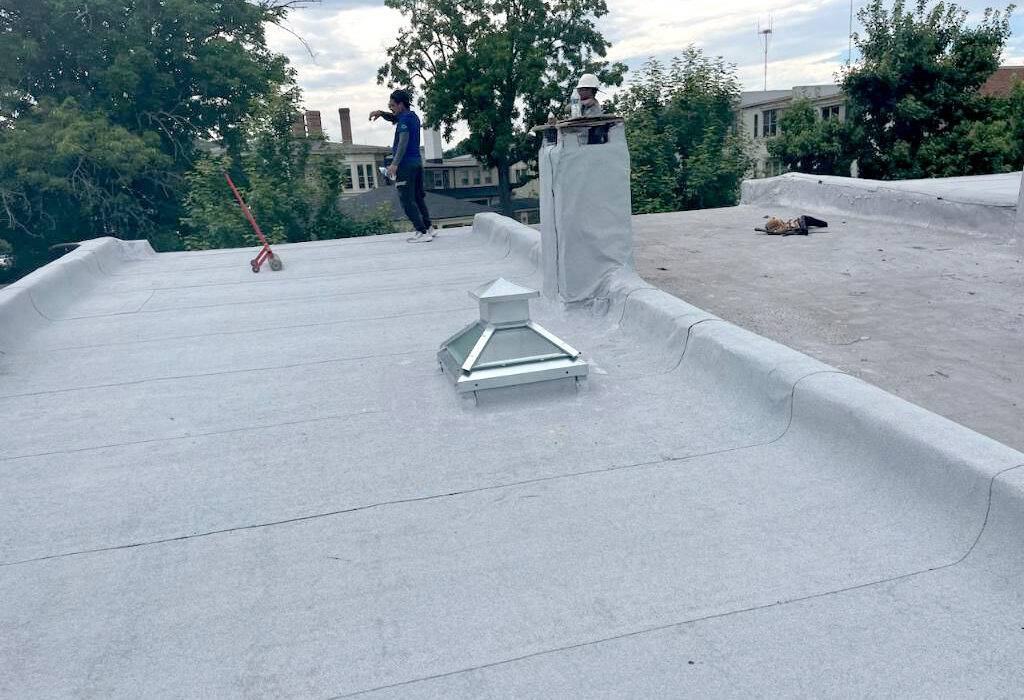Answering Questions About Your Flat Roof
Is a flat roof right for you? You’ll have a lot of choices to make while preparing for a new roof installation or roof replacement. Your roofing contractor will help you evaluate your needs and determine the best type of roof system for your home. You should consider your home’s architecture, your regional climate, your budget, and how much time you want to commit to roofing maintenance and roofing repairs. If you and your roofing contractor agree on a flat roof, you can prepare yourself for your flat roof installation by reading through these commonly asked questions.
What Is a Flat Roof?
A flat roof system is not actually completely flat. It has a low slope of ¼ to ½ inch per foot. This allows it to drain water, while still appearing flat to the average observer. Standard sloped roofs usually have shingles that allow water to slide over them, but a flat roof appears to be a continuous surface. Flat roofs hold snow and water longer than steeper roofing systems, so they are constructed with durable, watertight materials. They also require robust drainage systems, and seasonal maintenance to protect them from leaks and damage. There are three types of flat roof systems: membrane or single-ply, built-up-roofing (BUR), or modified bitumen (MBR).
When Is a Flat Roof Recommended?
A flat roof is recommended for any roof that has a pitch lower than a 14-degree angle. For shallow pitched roofs, a flat roof is the most effective and affordable option. Flat roofs are ideal in hot, dry climates that don’t see a lot of snow or precipitation. They are also recommended for homes that rely on solar power, as it’s much easier to install solar panels on a flat roof system. It’s also easier to install rooftop HVAC systems, evaporative coolers, and heating systems on a flat roof.
What Are the Advantages of a Flat Roof System?
Each type of flat roof system has different advantages and benefits:
- Membrane (single-ply) roofing – There are different types of membrane roofing materials, but the most common are rubber and plastic-based formulas. Most roofing contractors recommend ethylene propylene diene monomer (EPDM), which is a synthetic rubber sheet. Roofing installation consists of a layer of insulation board covered with the membrane material. Roofing repairs are simple and affordable, and the roof won’t need special reinforcement. Leaks are rare, and it’s easy to walk on the roofing system to complete repairs.
- Built-up roofing (BUR) – BUR was originally the most common type of flat roof system. It consists of multiple layers of tar or asphalt alternating with roofing felt. The top layer is gravel. This creates a seamless roof system that is tough, durable, and thick. BUR offers protection from water, UV rays, and extreme weather. It is also low-maintenance and cost-efficient. Roof repairs are simple because you can remove single layers at a time, and the gravel makes the roof resistant to foot traffic.
- Modified bitumen roofing (MBR) – MBR is a lighter-weight alternative to BUR. It is a flexible material composed of asphalt and a mineral top coating. It is installed in rolled sheets that are placed on top of a base sheet or membrane. Your roofing contractor will heat the underside of the roofing, melting the material to the base. It is faster and easier to install, so installation costs are typically lower. It is also low-maintenance and durable, and its elasticity and flexibility make it easier to repair and install.
How Much Do Flat Roofs Cost?
The cost of flat roof installation or roof replacement depends on the size of your roof, the complexity of the job, and the roofing contractor you use. The average cost of a flat roof system is between $3,000 and $10,000. The average cost of flat roof materials and flat roof installation is between $4-13 per square foot. Metal flat roofs are the most expensive, costing between $4-30 per square foot. Single-ply membrane roofs are typically the least expensive, costing between $4-7 per square foot.
How Do You Maintain a Flat Roof?
With proper care and maintenance, a flat roof system can last between 10-15 years. The lifespan of your flat roofing will depend on the climate in your region, the materials used, and how much sun exposure it gets. Your roofing contractor will give you advice on flat roof maintenance and will suggest either seasonal or annual roofing inspections depending on your area. In general, flat roof maintenance includes:
- Cleaning debris off the roof as needed
- Preventing snow and water from accumulating on the roof
- Maintaining your roof’s gutter system and drainage system
- Scheduling seasonal or annual roofing inspections to check for signs of damage
- Preventing pest and animal infestations on your roof
- Fixing leaks, tears, and other damage promptly
- Keeping unnecessary weight off of your roof
What Type of Drainage Is Recommended for Flat Roofs?
 Because flat roofs have such a low slope, you need to install a drainage system to prevent water from pooling and to avoid leaks and damage. The most common types of flat roof drainage systems are:
Because flat roofs have such a low slope, you need to install a drainage system to prevent water from pooling and to avoid leaks and damage. The most common types of flat roof drainage systems are:
- Inner drains – Your roofing contractor will install drainage pipes under the roof or in the parapet wall. They are installed in the center of the roof, or where the slope is directed. They are typically used on larger roofing systems. Water is drained off of the roof and away from the foundation without affecting the appearance or use of the roof.
- Scuppers – Installing scuppers involves creating an opening in the side of the wall that carries rain water from the roof to the gutter and downspouts. A collector head, gutters, and scuppers keep water away from your roof and foundation. This drainage system is less expensive, but clogs easily.
- Gutters – A gutter system is installed on fascia boards along the edges of the roof. They drain excess roof water off of the roof and away from the foundation. You will need to remove debris from your gutters regularly to prevent clogging, breakage, and damage.
- Siphonic roof drains – A siphonic roof drainage system directs water away from your home much faster than other drainage systems. It is particularly effective in regions with heavy rainfall. The siphon system moves the water out and then the pipes use gravity to direct water away from the roof and foundation. This system is small and unobtrusive, and less prone to clogging.
Schedule Flat Roof Replacement in Baltimore Maryland
If you need flat roof installation or flat roof replacement, contact our roofing contractors in Baltimore Maryland. At Harford Roofing & Exteriors, we have decades of experience installing, maintaining, and repairing flat roof systems. We can complete a roofing inspection to determine if it would be more cost effective to choose roofing repair or roof replacement. We will also guide you through the process of determining which roofing material will work best for your flat roof system. To ask a question or schedule an onsite assessment of your roofing, call us today at (443) 292-6020 or contact us online.

